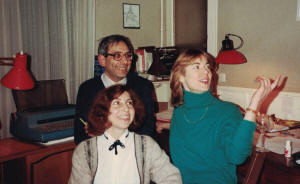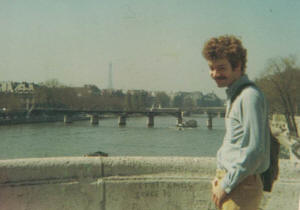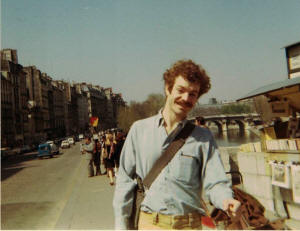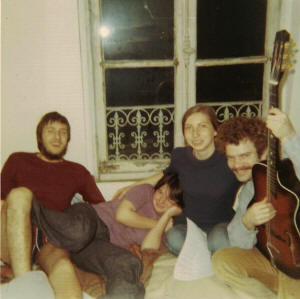TRAVEL DIARIES
Spring 1971
(Paris, with side trips to Amsterdam and London. Six weeks.)
As noted in the Introduction, I was not keeping a diary during my first three trips to France, so I’m filling in the gap by writing brief accounts of whatever I can remember that might be of interest.
For some background to this trip, see the first two sections of this part of my autobiography. To sum it up very briefly: In late 1969 a friend and I in Berkeley discovered some writings by the Situationist International (SI), a small, predominately European avant-garde group that had played a key role in provoking the May 1968 revolt in France. During the following year we experimented with our own situationist-type activities and met some other Bay Area people who were doing the same sorts of things. In December 1970 five of us formed a situ group called “Contradiction.” Two members of our group had recently returned from Paris, where they had met some members of the SI, and we had also corresponded with the American Section of the SI in New York. In April-May 1971 I made my own trip to Paris.
This was my first trip abroad. I went with my sister Kathy, who had already been to France once before. Back in those days Icelandic Airlines was by far the cheapest way to fly to Europe ($200 round trip), but you had to leave from New York. So Kathy and I met in New York City in late March. (At the moment I don’t have exact dates for my first three trips — the relevant letters that may later help me pin them down, as well as remind me of other events, are now in the Beinecke Library at Yale.) During the week before our flight, while Kathy was seeing other NYC friends, I met the two remaining American SI members, Tony Verlaan and Jon Horelick, along with Arnaud Chastel, a French friend of theirs who was currently living in and around New York.
I learned that Tony and Jon had recently had a split with the remaining European members of the SI. We discussed this split and other related breaks and exclusions at great length, and they gave me a thick stack of correspondence and other documents bearing on these matters, almost all in French, which I struggled to make sense of. (I had started to learn French in order to read the situationists, but at this point my knowledge of it was still fairly minimal.) Tony also gave me addresses of a number of contacts in France.
While I was in New York I also briefly met Bea Bookchin, ex-wife of the anarchist author Murray Bookchin. Michael Lucas (one of the members of Contradiction) had been good friends with Bea when he lived in New York, and he had given me her address. I was interested in meeting Bea because she had previously been married to Josef Weber, the Contemporary Issues theorist whom I greatly admired. I was not interested in meeting Murray, but he happened to be there when I went to her apartment. He scowled upon hearing that I was a situationist, but Bea calmed him down — “Now, Murray, take it easy!”
Besides these encounters I also got a little taste of New York. As I was walking around with Jon Horelick, we stopped for a moment to gaze at the cityscape and he said gleefully, “Just look — a whole city of nihilists!”
In early April Kathy and I flew to Europe, stopping in Iceland and then ending at Luxemburg. We then took a train to somewhere in West Germany and picked up a Volkswagen van that Kathy had bought. (She got it there and then later had it shipped to the United States for much cheaper than she could have bought it in the US, plus we meanwhile had the use of it in Europe.) We stayed one night in a German youth hostel, then drove the van to Paris. Arriving late in the evening, we simply parked it on a relatively quiet street and slept in it.
The next morning we had our first views of Paris in the daylight and I got a baptism of fire trying to drive in the crazy Paris traffic while Kathy looked at a map and gave me directions. We were constantly getting lost due to the fact that Paris streets are almost totally chaotic. In America, where the streets are mostly in right-angle grids, if you miss a turn you can usually simply turn at the next street, then turn again and be back at the street you were originally aiming for. If you try to do that in Paris (and many other older European cities) you’ll get totally off track because the streets go at all angles.
Anyway, we got a little preliminary flavor of the city, then hunted up one of the addresses that Tony had given me: Roger Grégoire and Linda Lanphear at 14 Rue Fagon (a little street just off Place d’Italie). We trudged up to their seventh-floor apartment, knocked on the door, and introduced ourselves. They welcomed us, and upon learning that we had no place to stay, invited us to stay at their place. We all got along fine, and Kathy and I ended up staying there for most of the rest of our trip.
Roger had met Fredy Perlman in Paris during the May 1968 revolt, and the two of them wrote an excellent booklet describing their experiences (Worker-Student Action Committees: France, May 1968). Later that year Roger visited Fredy in Michigan and joined the newly formed group Black and Red, which included Fredy Perlman, Lorraine Perlman, Linda Lanphear, and a few other people. The group had absorbed some situationist influence, and in 1970 co-published the first English translation of Guy Debord’s The Society of the Spectacle. The American SI section (Verlaan and Horelick) criticized the quality of that translation and the eclecticism of Black and Red’s co-publisher, Radical America. Roger and Linda, who by that time had moved to Paris, sent out a leaflet “To the Readers of Black and Red,” affirming their agreement with the SI’s critique of Black and Red.
Kathy, incidentally, had no particular knowledge of or interest in any of these political matters, but she has always been a very friendly and vivacious person, able to get along fine with just about anybody. I don’t have any photos of her from this trip, but here she is with Roger and Linda during another Paris trip several years later:
Like many of my Paris friends then and later, Roger and Linda lived on the very top floor, which tended to be the cheapest rent since you had to walk all the way up. At that time there were almost no elevators in Paris except in a few very expensive places. Roger and Linda’s apartment did not even have a shower. They made do with a tiny and rather precarious portable shower whose floor could be placed on the toilet stool so that the water drained into the toilet.
Also, very few people had phones. Even if you did have one it didn’t do much good, because most of the people you knew didn’t have one. On the other hand, mail was delivered twice a day in Paris, so for most purposes people would simply send a postcard — “Can you come over for dinner tomorrow?” It would be delivered later the same day, and the response, in case the invitee couldn’t make it, would get back to the inviter by the next morning, in time for the latter to make other plans.
For more immediate or impulsive contacts, you might simply go over to the person’s place — perhaps taking a half hour or more walking or taking the Métro (the Paris subway). If they weren’t there, you might leave a note. Then when you got back home you might find that they had stopped by your place and left you a note. On the other hand, the journey itself was pleasantly leisurely. Since portable phones did not yet exist, when people were away from their home — in the streets, at a café, at work, in a store, or wherever — they tended to pay more attention to the situation and the people around them, though they might, of course, read a newspaper or a book if they were sitting in a café or in the Métro. I appreciate emails and phones as much as anyone, but the fact remains that back then people gave the impression of being more relaxed and aware and interactive when they didn’t have all these instantaneous connections going on 24/7.
Shopping for food was also a much different, and for the most part better, experience. You would trudge downstairs with your shopping bag and go from one small shop to another, most within two or three blocks of almost anywhere you lived — little storefronts or sidewalk stands, each with its narrow specialties — exclusively for bread (baked fresh twice a day), for pastries and desserts, for dairy, for cheeses, for meat, for seafood, for vegetables and fruits, etc., all delivered fresh each day. There was relatively little packaged or canned food and supermarkets were almost nonexistent. There were also cafés all over the place, mostly outdoors. And hundreds of bookstores, large and small, as well as thousands of other little stores of all types, some fairly banal but many with their own peculiar and intriguing ambiences. And far less auto traffic than there is now.
Just being in Paris was exciting — taking in all the new sights and sounds and smells, losing myself in the labyrinthine street layout, wandering for hours through cobblestone alleys among centuries-old buildings and obscure little shops, stopping at outdoor cafés and watching all the passersby, catching tantalizing fragments of the strange language I was just beginning to be able to understand. Or dining with friends, savoring tasty multicourse French meals and excellent wines and liqueurs that we would linger over during hours of lively conversation.
This was all very pleasant, but I had come to Paris primarily to meet the situationists. Once I was there I wrote to the Situationist International itself (whose remaining members were Guy Debord, René Viénet, and René Riesel in France, Gianfranco Sanguinetti in Italy, and J.V. Martin in Denmark); to Raoul Vaneigem and François Beaulieu (both of whom had resigned from the SI in 1970); and to a few other people in the situ milieu. In retrospect my letter to the SI was probably too presumptuous. In it I mentioned our Bay Area group’s increasingly close collaborations with Verlaan and Horelick, with whom Debord and the others had broken, so it was not surprising that the latter saw little reason to engage with our group. Vaneigem and Beaulieu, on the other hand, were both quite willing to meet me.
Roger and I met Vaneigem at a bar and had a lengthy and very pleasant talk, with Roger translating (my spoken French was still pretty limited at this point). Vaneigem was very genial and gracious. He praised my poster Bureaucratic Comix and gave me several of his own comic posters that had in part inspired mine.
The encounter with Beaulieu was less interesting. About the only thing I remember about it was that in his apartment he had an entire wall of books about Paris, its history, its neighborhoods, etc. — there must have been several hundred of them.
Other people I met in the Paris situ scene included Gérard Lambert (who formed a three-member group with Roger and Linda); Pierre Brée and his girlfriend Claudie (who were also staying at Roger and Linda’s much of the time); Daniel Joubert (one of main perpetrators of the 1966 Strasbourg scandal); the GRCA (Groupe Révolutionaire Conseilliste d’Agitation — Revolutionary Councilist Agitation Group), consisting of Jean-Louis Rançon, François Lécuyer, Jacques Le Glou, and Alain Chevalier (the latter an ex-SI member); and a few others whose names I don’t remember.
Our discussions were a mixture of genuinely interesting exchange of information and ideas with the exaggerated hopes and illusions that had sprung up in the heady aftermath of May 1968. Among other things, we were particularly interested in wildcat worker struggles. The May revolt (which had culminated in a wildcat general strike that brought the whole country to a standstill) had provided plenty of suggestive examples, and one of the SI’s unrealized projects had been to create a “Wildcat Striker’s Handbook.” (To a certain extent this project was realized a few years later with Vaneigem’s little book From Wildcat Strike to Total Self-Management.) Some of our Parisian contacts had taken part in such strikes, and we discussed those experiences in detail and considered what one might best do in such circumstances — which tactics seemed to be fruitful and which didn’t. Such perspectives may seem unrealistic to many present-day readers, but at that time the French authorities certainly didn’t think so. Everywhere you’d go in Paris you would see large police vans full of grim-faced riot police, sitting there stewing all day and ready at a moment’s notice to rush to suppress any sort of gathering or demonstration before it could spread and catalyze another May revolt. Radical bookstores were constantly bustling and you’d frequently run into lively spontaneous debates on street corners and in cafés. There was still a widespread sense that May ’68 had called everything radically into question, and that follow-up revolts might break out at any time.
(Meanwhile, my fellow Contradiction members back in the Bay Area were creating and circulating Wildcat Comics — an example of the scandalous agitations we were experimenting with at that time, even if some of the rhetoric may seem a bit corny in retrospect.)
After two or three weeks in Paris, Kathy went out of town for a few days with some friends of hers and left her van with me. I used it to drive with Roger, Linda, and Gérard to Amsterdam, spending the night with some contacts near Brussels and arriving there the next day. We had intended to explore the Institute of Social History, but it turned out to be closed on the day we were there. In any case we had a nice time wandering around the city, with its intriguing interplay of streets and canals, and checked out the bookstore of the publisher Van Gennep (who had recently republished the complete twelve issues of Internationale Situationniste as a thick volume).
Toward the end of our trip, Kathy’s and my parents flew over to join us in Paris (their first ever trip to Europe). After a couple days of sightseeing in Paris, we drove her van to England (including a seasick-inducing crossing of the channel on a ferry); spent a couple days sightseeing in London; then continued on to Wales to visit some old friends of our parents. They and Kathy stayed there a few more days, but I took a train back to London, where I saw David Wise (a King Mob member whom I’d met in Berkeley a few months earlier) and met Ian Clegg (author of Workers’ Self-Management in Algeria) and one or two other radical contacts. Then I headed back to Paris.
On my return to the United States in late May I stopped once again in New York, staying for a couple weeks with Tony Verlaan and his girlfriend. While I was in Europe, Tony had broken with Jon Horelick (who more or less disappeared until two years later, when he published his journal Diversion). Tony and Arnaud Chastel had then formed a new two-person group called Create Situations and they were in the process of translating several SI articles into English. Though my spoken French was still minimal, my reading knowledge of French was by this time quite a bit better, and I was able to go through their translations and suggest quite a few corrections and revisions. Then I returned to Berkeley.
Account of Ken Knabb’s 1971 Paris trip.
No copyright.
Next Trip
(1973)
Other Travel Diaries
Bureau of Public Secrets, PO Box 1044, Berkeley CA 94701, USA
www.bopsecrets.org knabb@bopsecrets.org



